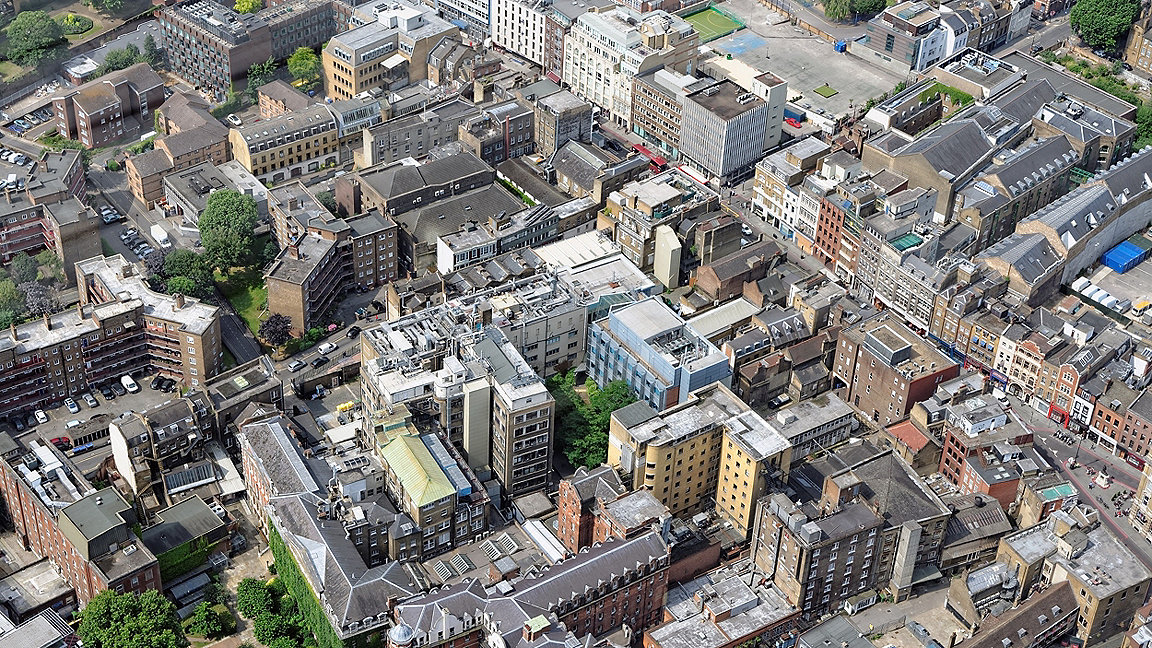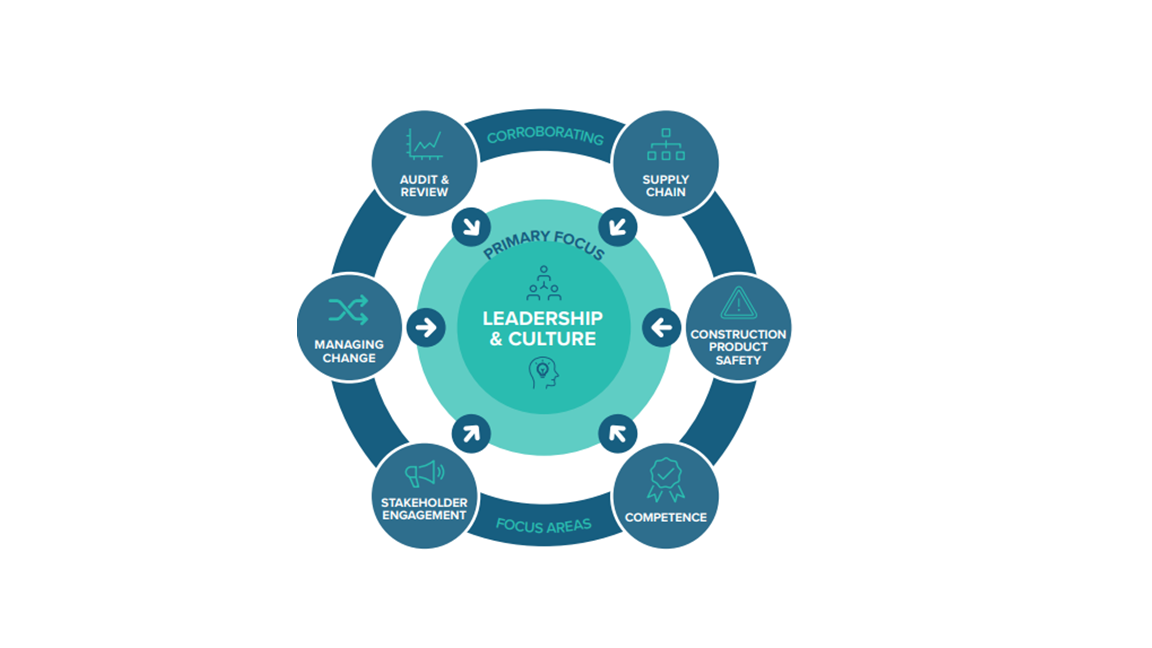
In 2017, building safety in the UK came into sharp focus following the Grenfell Tower fire. Multiple factors contributed to the disaster, but can collectively be described as a major failure of leadership commitment and organisational culture by all parties involved. This was reflected across the broader sector.
As part of the construction industry's response to the fire, the Building a Safer Future Charter was established in 2019.
It was drawn up by a group consisting of four tier-one contractors, four local authorities and four housing associations – all based in England – with the support of the then Ministry of Housing, Communities and Local Government.
In October 2020, the Considerate Constructors Scheme (CCS) was appointed by a founding group of early adopters of the charter to assume responsibility for managing and developing it.
The following month, CCS established Building a Safer Future (BSF), a not-for-profit organisation with an independent governance structure.
Its aim is to develop the charter by helping the sector improve leadership commitment to and organisational culture around building safety.
The charter contains five key commitments on building safety, which are intended to serve as guiding principles for organisations to uphold. In brief, these are as follows.
In setting out these principles, the charter seeks to promote improvement in building safety.
Although the construction industry has made significant progress in occupational and site safety in recent years, there remains a notable gap between occupational safety and building safety.
BSF's singular vision is to put building safety above all other considerations. It aims to support the built environment sector in its transition from complacency to a culture of continuous improvement and proactive safety management.
By promoting this agenda, BSF is actively helping organisations improve oversight and governance of building safety, reduce their overall risk profile, and rebuild public trust.
Central to BSF's early efforts was the introduction of early adaptors as registered signatories in 2019.
This status began as a way for organisations to declare publicly their commitment to the five principles, and to progress and uphold building safety at all operational, technical and strategic levels.
There are now more than 350 registered signatories to the charter.
To model sustained cultural change towards building safety, BSF looked further afield to learn from a number of other high-hazard sectors – such as oil and gas, rail, maritime, chemical, nuclear and aviation – and their respective risk and safety management systems.
BSF also sought to create an independent assessment framework specifically for those operating in the built environment.
Underpinned by the 53 recommendations of the Hackitt review, the BSF champion assessment was piloted in August 2021.
Dame Judith Hackitt has been instrumental in raising awareness of BSF and the assessment, endorsing the scheme alongside the Industry Safety Steering Group, Construction Leadership Council and the Health and Safety Executive; the latter in particular in its role as Building Safety Regulator.
The BSF champion assessment presents a range of entry routes, referred to as modular pathways.
Each consists of a bespoke set of options, catering to the varied activities of individual organisations.
It also includes a series of statement-based expectations, against which organisations are assessed. Organisations respond to these expectations by asserting they are fully or partially met or not met, and provide supporting evidence.
For instance, one expectation on competency is: 'To ensure continuous improvement in building safety risks, monitoring, inspection and audit activities are undertaken according to an agreed and implemented plan, and this is available at each gateway stage as required'.
Another, concerning the supply chain, is: 'Contracts are written to support building safety, and are based on collaborative procurement approach with clear and meaningful key performance indicators and project scorecards'.
Different professions involved in the construction process follow their respective pathways, namely: building owners and building management companies; principal designers and principal contractors; designers and other providers of professional services who do not take the principal designer role.
These other providers include: architects, consultants, structural engineers or fire engineers; construction and procurement frameworks that represent public bodies or private organisations; housing associations, social housing providers; and local authorities.
The BSF champion assessment comprises two stages.
Stage one entails two psychometric surveys to be completed by a significant sample of participants across different teams, functions and seniority levels to measure perceived effectiveness in the organisation.
These surveys explore 18 themes that pertain to leadership commitment or organisational culture.
Responses are then validated by an independent assessor through a series of confidential discussions with a sample of respondents.
Stage two is a detailed self-assessment of an organisation's systems, policies, processes and procedures against a number of critical expectations in building safety.
These explore elements such as supply chain management, construction product management, assurance of competence, stakeholder engagement, management of change and audit and review.
Participants in stage two – typically, functional or technical specialists – are appointed by the person leading the BSF champion assessment internally, who are referred to as the company leaders.
The persons these leaders appoint are responsible for asserting whether the framework expectations are fully, partially or not met, providing a short explanation as well as evidence.
Assertions and evidence are reviewed and verified by the assessor, who plays a highly supportive role throughout the process.
Where organisations successfully meet all expectations, the assessor will use their stretch targets and supplementary expectations to form a continuous improvement plan; while for organisations that do not or only partially meet their expectations, the unmet ones will be the basis of such plans.
These expectations are divided into priority and non-priority, and feature in the improvement plan to help organisations intervene in a timely manner across systems, processes, procedures and policies and the way these are used, applied and understood in practice.
The plan is then formalised on completion of the assessment, with an understanding this will be worked toward until interim assessment with BSF.
Following successful completion of both stages, organisations are awarded BSF champion status.
They receive two detailed and comprehensive narrative reports: one for leadership commitment and organisational culture, and another for corroborating elements.
The reports are supported by statistical data from the surveys at stage one, which provide insight into strengths, best practice and innovation, as well as weaknesses and opportunities for improvement, to support leadership commitment and organisational culture in the transition towards building safety.
Additional summaries of strengths and weaknesses in key management processes are also provided.
After the reports are presented, successful organisations will be reassessed against the continuous improvement plan by BSF on an interim basis, one year after the organisation becomes a champion.
Acknowledging and focusing on high-risk areas as part of this reassessment encourages transparency and open discussion, so issues are addressed rather than ignored.
By critically assessing areas that seem to be performing well, organisations also enable continuous improvement and stay vigilant about potentially overlooked risks or areas for further enhancement.
Figure 1 below shows the structure of BSF's assessment framework. Leadership commitment and organisational culture are at the heart of the process and assessed by leadership and culture surveys.
Arranged around this are the themes that inform the assessment expectations.

Figure 1: BSF champion assessment framework © BSF
There are ten BSF champions at present: Barratt Developments; the Casey Group; Galliford Try; Hill Holdings; Martin Arnold; Morgan Sindall Construction; MHS Homes; Orion Fire; Persimmon and Salix Homes.
Many more organisations are currently being assessed as well.
BSF champions are more than just flag-bearers; they play a pivotal role in building safety throughout the sector.
With specific duties and responsibilities, they directly influence the practice of the RICS members who work with or for the organisations that are champions or currently being assessed.
Engagement with or from BSF champions will increase the attention we pay to building safety culture, and enable the necessary change detailed in the Hackitt review.
This applies across all BSF champions, and will instil a heightened awareness of safety.
The comprehensive assessment process for champions demonstrates that high standards of leadership and organisational culture on safety bring immense value.
Collaboration between RICS members and BSF champions is not just advisable but necessary to fulfil the shared vision of a safer future, whether this is working together in a formal capacity, taking part in working groups, undertaking joint ventures or partnership initiatives, sharing best practice or shaping industry practice.
BSF interim chief executive Gary Townsend-Vila says: 'We are incredibly grateful for the support of RICS since our inception, from being a key corporate supporter to hosting the launch of the BSF at RICS HQ.
'It is great to see organisations progressing through the champion assessment in light of the support RICS has provided, and we look forward to seeing more RICS members join those leading the way in building safety leadership and culture.'
Inflationary pressures and new building legislation and regulation can create a sense of uncertainty and confusion, compounded by lack of understanding of the differences between building safely and building safety.
Building safety is more than just a technical obligation: it is a moral and social responsibility.
The Grenfell Tower fire underscored the importance of this, highlighting major flaws in the sector's commitment and culture, and serves as a constant reminder of the catastrophic outcomes of a lack of safety culture and leadership oversight.
Independent, supportive third-party initiatives and tools such as the BSF champion assessment, which support the necessary cultural change in the built environment, must be embraced if we are to build a safer future together.
Companies can apply to participate in the BSF champion programme by completing the online application form. Alternatively, to find out more about the assessment process, book a place on one of our upcoming webinars.
RICS global building standards director and fire safety lead Gary Strong says: 'RICS has been a corporate supporter of the BSF since its launch at RICS HQ, and encourages RICS-regulated firms and members to support the BSF themselves.'
'Building safety is more than just a technical obligation: it is a moral and social responsibility'
At RICS, we want our SME members to flourish. Our SME Business Support Hub is a great place to start finding out more.
Whether an experienced or start-up SME, you'll find tailored support and resources, such as:
We also send a monthly SME newsletter, sharing relevant support, insight and knowledge. You can sign up for this by emailing RICS directly.
Our quarterly UK Economy and property market update is also designed with SMEs in mind, providing the kind of detailed analysis and insight that may otherwise be out of reach. We conduct regular webinars as well, to take members through the latest updates and provide a forum for their questions.
BUILT ENVIRONMENT JOURNAL
David Greenwood and Arpan Gupta 23 April 2024
BUILT ENVIRONMENT JOURNAL
Neil Hope-Collins 16 April 2024
BUILT ENVIRONMENT JOURNAL
David Browne 09 April 2024